Part 11 – Seeing the Divine
Above: Detail of Christ, Deesis* mosaic in the Hagia Sophia (13th century) Istanbul, Turkey.

Deesis* mosaic in the Hagia Sophia (13th century) in Istanbul, Turkey. Photo from Random Republika.com
*Deesis is the name of the artistic depiction were Christ is flanked by Mary and John the Baptist each with hands raised in a gesture of prayer for the world.
Uncovering a Masterpiece
It has been acclaimed as one of the finest examples of Byzantine art in the world – a masterpiece that defies comprehension, but for a time, the world had forgotten it was even there…The following excerpts are from the amazing website of Bob Atchison dedicated to sharing the Deesis mosaic of Christ located in the Hagia Sophia Cathedral of Istanbul, Turkey.
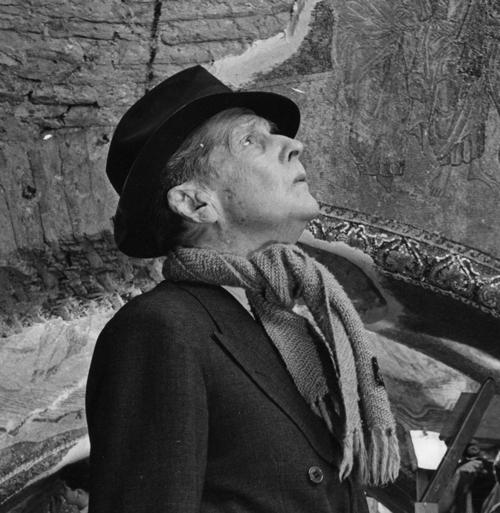
Thomas Wittemore (1871-1950)
“In December of 1931, Thomas Whittemore led a team of archeologists, historians, craftsmen and restorers from the Byzantine Institute of America to Istanbul in order to do a complete survey of the Church of Hagia Sophia. Recently converted to a museum after use as a mosque for almost 500 years, the Institute had the complete support of the Turkish government. This scientific expedition was, in fact, a kind of treasure hunt; using a map left by a pair of Swiss architects who had worked in Hagia Sophia almost 100 years before, the team was using their notes to find Byzantine art that had been lost for almost half a millennium. The Fossati brothers, Gaspare and Giuseppi, in their 1849 restoration and redecoration of the mosque, discovered, sketched, and re-concealed several major works of Byzantine art. The Institute had the brothers’ sketched reconstructions, and ideas about where the works might be located, but only had the vaguest hope to find them – Hagia Sophia had sustained massive damage in an 1894 earthquake, and there was no guarantee that the works remained. Whittemore, however, was undeterred and began examining a wall in the eastern part of the upper south gallery, quickly striking gold. The team had found what they were looking for.”
“When Hagia Sophia functioned as a church, this restricted area had been reserved for the emperor and the imperial family, their courtiers, and entourages of attendants and guards. From its great height and exceptional position, this place was the supreme vantage point in the church, with a perfect view of the nave of the church, especially the altar area. One could arrive directly from the Great Palace without having to enter the lower section of the Hagia Sophia. Outside, there was a covered passage from the palace that accessed an external wooden staircase. The stairs are long gone, but the portal remains, and memories survive there for there are still inscriptions scratched into the marble door surround—on both the inside and the outside—that are over a thousand years old, and in different languages, left by the people who were privileged to have access.”
“This area of Hagia Sophia is particularly bright and spacious because of the huge windows and the fact that the facade here is unobstructed.”
“When Thomas Whittemore and his team arrived to begin work they found a thousand cases of documents from the Hagia Sophia mosque archives pushed up against the walls [of this area].”
“The first incision into the plaster took place on July 14, 1934. The first season of work took four months and ended in late November of the same year. The uncovering of this mosaic panel was the first step – further conservation, consolidation and study lasted through seasons of work in 1936, 1937, and 1938. It was a slow and deliberate effort. As the team uncovered the mosaic, they realized that were unveiling a work of art of world significance–this filled them with awe, and made them even more cautious in their excavation and conservation.” – Bob Atchison
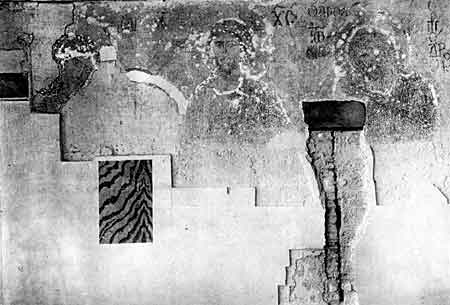
Deesis mosaic at the Hagia Sophia cathedral emerging during restoration in 1934.
“The pictures that somehow got out caused quite a sensation in the press. The lost world of Byzantium was a story that fascinated people. Hagia Sophia was one of the most famous buildings in the world – one of the seven modern wonders, a miraculous survivor of earthquakes, religious conflicts and conquering armies. When the Deesis panel was uncovered it was an embodiment of many things at once: the history of the building, a spirit of suffering, humanity and Heaven – all in one. It was of such extraordinary quality and beauty that it was immediately hailed as one of the greatest treasures of world art and still is today.”
“Publication of the discovery of the mosaic created a sensation in the art world. Never before had a Byzantine mosaic of this artistry been seen and the level of technique surpassed anything previously known. The mosaics went a long way towards redeeming Byzantine art in the view of art historians and public opinion, the art of Byzantium having been denigrated for centuries. The extraordinary quality of the Deesis and the stunning visual impression it made upon all who saw it, changed minds about the importance of Byzantine art, its originality and creativity.” – Bob Atchison
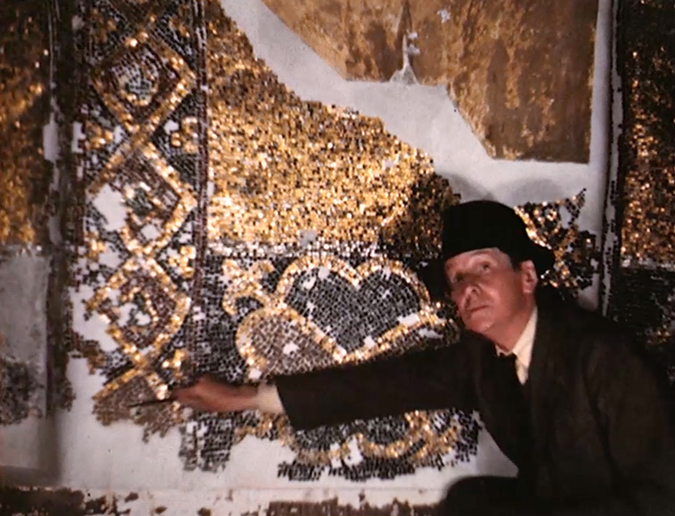
Thomas Whittemore tracing and explaining decorative mosaic patterns in the Hagia Sophia (1940). Photo by Dumbarton Oaks Research Library and Collection.
Explore more of Bob Atchison’s writing and work here >
Seeing is Believing
Jesus had spent much of his ministry performing miracles, powerful visual testimonies to his divinity and opportunities for those who beheld them to repent and believe. One day after healing a mute demon-possessed man, Jesus was accused of getting his powers from Satan. In his rebuke to those who continued to suffer spiritual blindness, Jesus used the following illustration:
Your eye is a lamp for your body. A pure eye lets sunshine into your soul. But an evil eye shuts out the light and plunges you into darkness. Make sure that the light you think you have is not really darkness. If you are filled with light, with no dark corners, then your whole life will be radiant, as though a floodlight is shinning on you. – Luke 11:34-36
Those who couldn’t see Christ’s miracles for what they really were, couldn’t see who He truly was either. The world sets before our eyes its false promises of happiness and contentment. I like Coca-Cola, but there is no “Coke side of life” as advertisements once told us.
Let us fix our eyes on Jesus, the author and perfecter of our faith. – Hebrews 12:2
We have been handed down over the centuries beautiful artworks, pieces that have tremendous potential to provide a kind of visual refuge to preserve and protect us from the increasingly negative and dissatisfaction-inducing culture of images we find ourselves in today. Author Henri Nouwen, in his book Behold the Beauty of the Lord, talks about even as he moves away from certain artworks, and he engages in his daily tasks, he feels as though he did not have to leave the holy place he had found therein. I find that to be a profound way to walk through daily life.
Portraying Christ
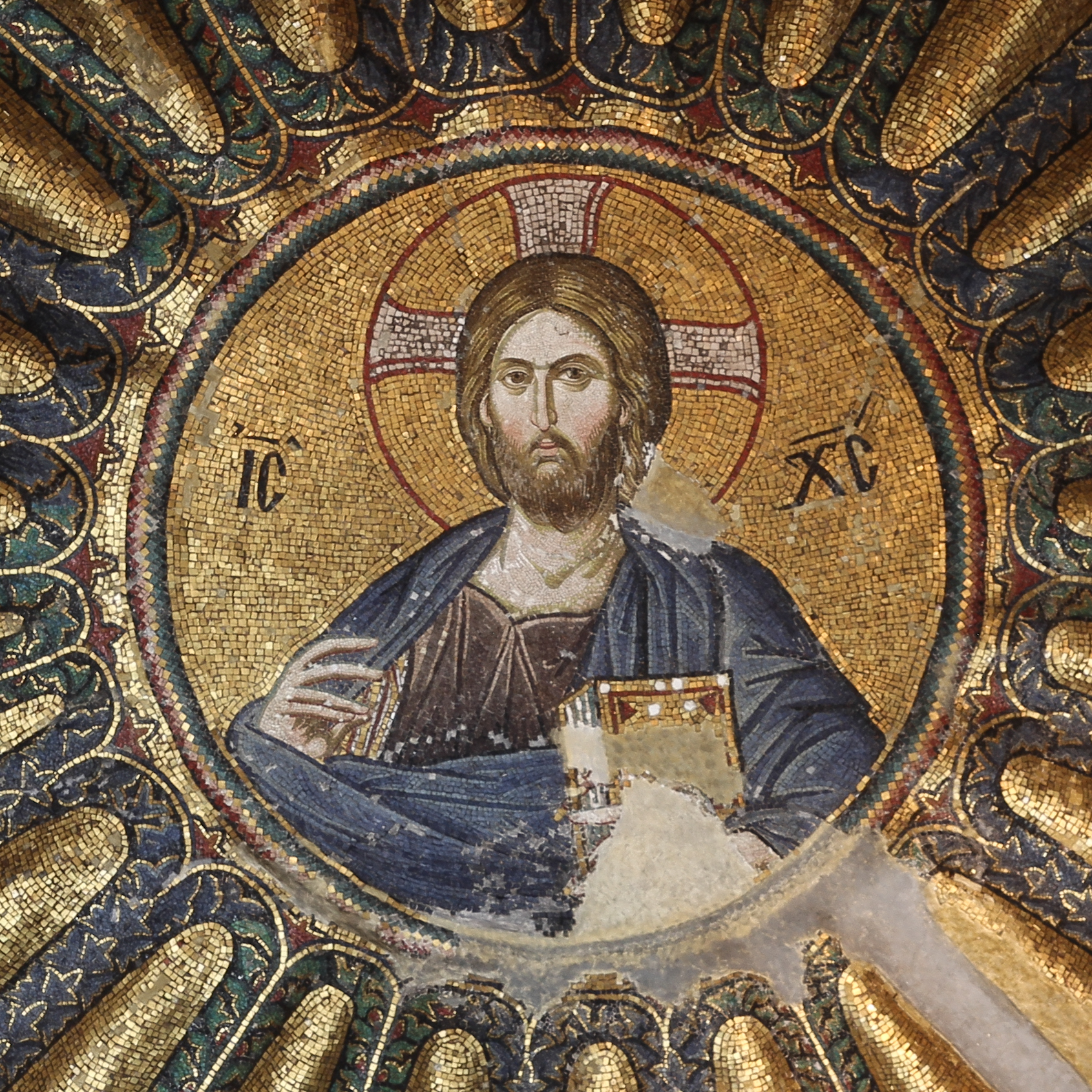
Mosaic of Christ Pantocrator, south dome of inner narthex at Chora Church (prior to 1320), Istanbul, Turkey.
Over the centuries, there developed certain “rules” or “traditions” among Christian art-makers pertaining to the portrayal of Christ. There were approximately 10 poses that were considered acceptable when depicting Jesus. (It was also considered not appropriate for any depiction of God the Father to be created as Christ himself told his Philip when he requested to see the Father: “Have I been with you so long, and yet you have not know Me, Philip? He who has seen Me has seen the Father..” – John 14:9 I kind of agree with this stance.) For instance, one of the rules is to never portray Christ in profile – he must always be shown full-faced, a proof of him being fully man. Look at the image above from the Chora Church in Istanbul (a place Thomas Whittemore also restored mosaics and which I also had the privilege of visiting), and I will walk you through this image.
The particular pose we see Jesus in here is called Christ Pantocrator. Pantocrator is the Greek word meaning almighty, all-powerful, “ruler of all”, “sustainer of the world”. Pantocrator is the name given to Christ in the book of Revelation where it appears 9 times. You get a “feel” for this when you stand beneath a larger-than-life image of Christ such as at the Hagia Sophia or Chora churches.
In a Byzantine church such as the Chora Church, Christ Pantocrator would be the largest and most centrally located image, usually occupying the church’s central dome. In the Pantocrator pose, Christ is pictured holding the gospels in his left hand and makes a gesture of blessing with his right hand or some say the gesture of the right hand is the orator’s gesture, indicating Christ has the authority to speak. He gazes directly at the viewer, and his eyes have that strange ability to follow you.
The facial expression of an icon, of which this is a great example is known as “joyful sorrow”. In it we see a seriousness touched by sadness. Yet the mouth is often just on the verge of a smile, and the eyes seem to be filled with hope. It’s this kind of expression that makes an icon very approachable. In our human states, our moods and emotions change, even so, you can always come before Christ and feel as though he is identifying with what you are feeling…He is inviting you into conversation.
Note what we would call a halo, the correct term is nimbus, is found in virtually every icon, no matter who the person portrayed except for Satan, who you might see in an icon portraying an event (he usually looks like a stately older gentleman, but don’t be fooled – no nimbus!). The nimbus is a visual idiom used to indicate holiness, being Spirit-filled or the light of God radiating from within. While all other persons are portrayed with a simple, unadorned and empty nimbus; unique to icons of Christ, is the cruciform nimbus, or cross-filled halo (a visual aide in helping identify Christ).
Christ wears an under-garment of deep red signifying His humanity with a gold band across the right shoulder (in this example from Chora we see just a bit of the gold band peaking out under his robe) indicating His rank as highest among all men. He wears an over-garment of blue signifying His divinity.
Although many took much liberty with the poses and styles of their art, Renaissance masters still held to traditional elements when portraying Christ. Titian and El Greco provide some nice examples to that end.
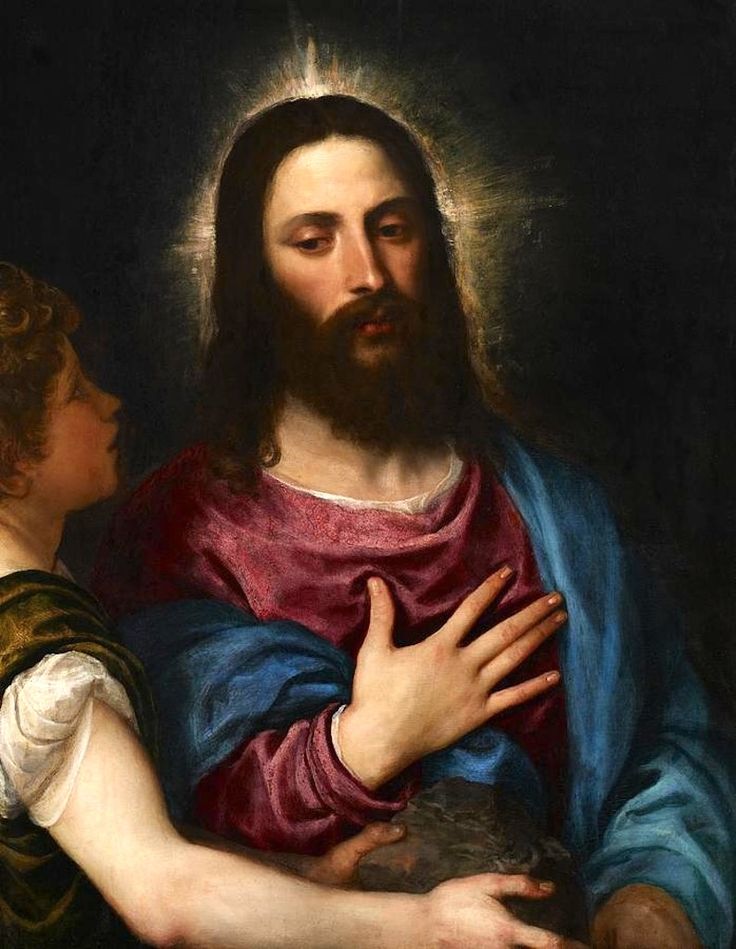
The Temptation of Christ (1516-25) by Titian
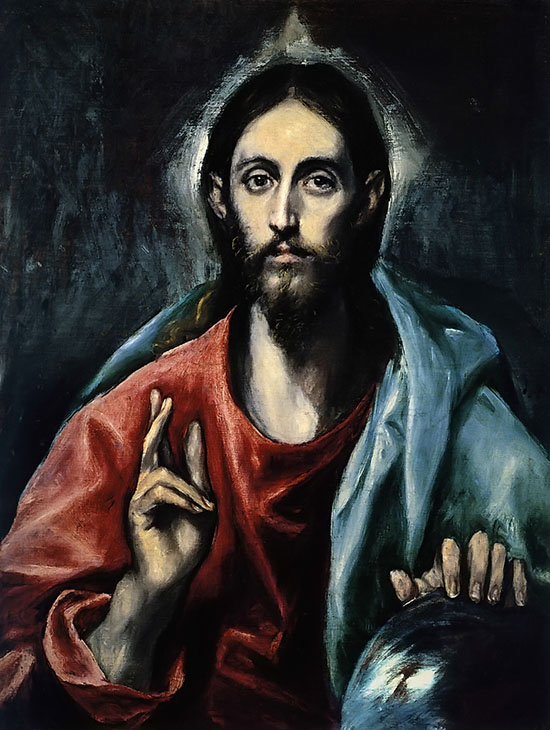
The Savior of the World (1600) by El Greco
Final Thoughts
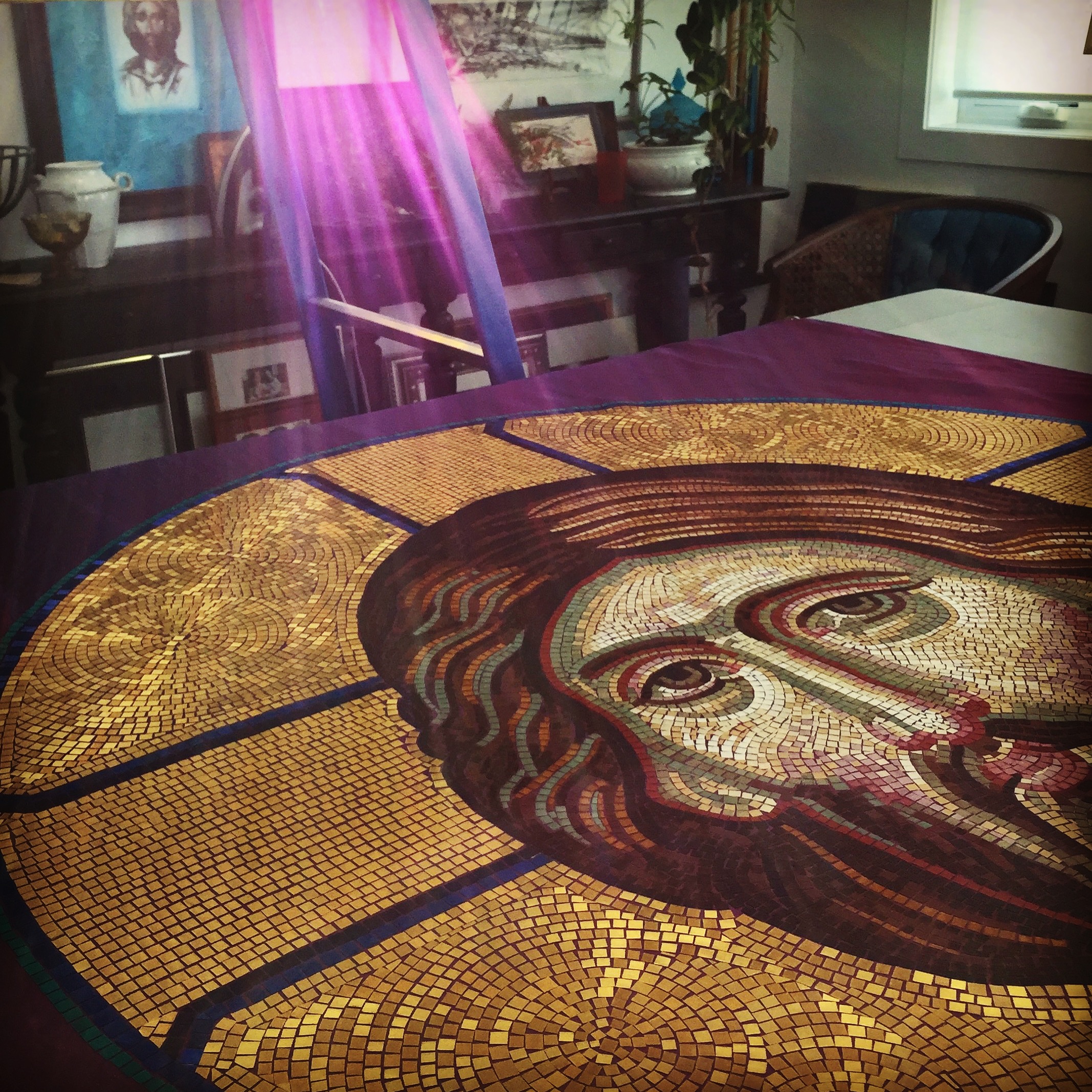
Light falling on Christ Pantocrator mosaic textile work in my studio during a photo shoot (2016), photo by Michelle L Hofer
When pure sunlight strikes thousands of glass gold-leafed tiles that have been tilted with precision to the exact angle at which they will catch the fullness of the light streaming in from the window to the east, the effect is beyond words can describe. Suddenly Christ is illuminated…it is pure magic. His glory radiates with a brilliance that matches the descriptions of Old Testament Prophets. This is the experience of being in the presence of the Deesis mosaic of Christ when I saw this wonder in 2001.
I was inspired to create something as close as possible to this artwork. My piece is made in fabric. I hand-cut some 20,000 fabric squares and applied them onto a sheer background fabric. The overall piece is approximately 5 x 9 feet in size (slightly larger than the original mosaic). It is the most difficult thing I’ve ever made. It took me far longer than the Byzantine master (most likely assisted by apprentices) created his work.
The master artist was completely at home in this difficult technique using the skill of a miniaturist on a monumental scale. – Bob Atchison
Awe…that wonderful, God-given response. When as humans we can create in such a way as to open the door even a crack to allow someone to experience the often indescribable sensation of awe for the Divine, then the artist has fulfilled his calling, faithfully used his or her gifts to God’s glory and for His namesake. This is art’s highest achievement. I cannot set down these thoughts, cannot place them to the side. As an artist, I simply want to create for and with the Creator. Landscapes have their place, but sacred art is just that…sacred – turning the mind and attention to where it belongs…on the Almighty Ruler of this world, our Prince of Peace, our High King, our Gentle Shepherd.
To God be all the glory and power forever, AMEN.
Down an Ancient Path
The BIRCH TREE STUDIO BLOG
